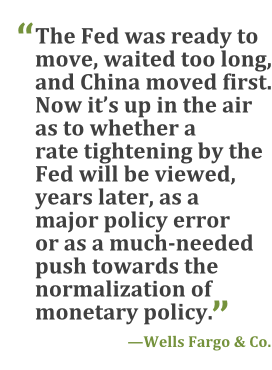What happens when the Federal Reserve loses its strangleholdover debt markets? Investors are finding out.
|The selloff in corporate bonds is deepening, and investors areseeking safety in the longest-dated government debt, which doesbest when the economy does worst. Defaults are rising as oiltumbles and investors are looking for the best ways to hedgeagainst credit losses.
|All this comes as the Fed does, well, nothing much. Instead,it's China that's taken the lead with new rounds of financialstimulus in the face of slowing growth. But some days it's afree-for-all, with even Kazakhstan wielding its influence.
| “Financialmarkets are desperate for the Fed to drive trading themes, but the'world's central bank' has fallen to the second rank this summer,”or sometimes third, Jim Vogel, an interest-rate strategist at FTNFinancial in Memphis, Tennessee, wrote in a note Thursday.
“Financialmarkets are desperate for the Fed to drive trading themes, but the'world's central bank' has fallen to the second rank this summer,”or sometimes third, Jim Vogel, an interest-rate strategist at FTNFinancial in Memphis, Tennessee, wrote in a note Thursday.
Benchmark U.S. interest rates are still at about zero, and evenif the Fed makes a move this year, it'll only increase those ratesby a fraction of a percentage point. In other words, U.S. monetaryconditions are still very easy, more than six years after the worstfinancial seizure since the Great Depression.
|And perhaps this is precisely the problem: The Fed may havewaited too long to back away from its crisis-era policies, and itnow has ceded control to the next default cycle and the whims ofother global central banks. That's being treated as bad news bycredit buyers, who are now demanding close to the highest premiumto own junk bonds instead of government bonds since 2012.
|“The Fed was ready to move, waited too long, and China movedfirst,” wrote Wells Fargo & Co. analysts led by Richard Gordonon Aug. 18. “Now it's up in the air as to whether a rate tighteningby the Fed—any rate tightening—will be viewed, years later, as amajor policy error or as a much-needed push towards thenormalization of monetary policy.”
|Investors have sent yield spreads on U.S. junk bonds up 0.64percentage point this year to 5.68 points, according to Bank ofAmerica Merrill Lynch index data. Those on speculative-grade energysecurities have surged to 9.64 percentage points, close to the mostsince 2009.
|Instead, investors are piling into Treasuries that mature inmore than 15 years, with that debt returning 2.1 percent so farthis month and yields falling toward the lowest since April.BlackRock Inc.'s US$5.5 billion exchange-traded fund that focuseson longer-term U.S. government bonds received $447.7 million ofdeposits in the past week, the most among its fixed-income peers,data compiled by Bloomberg show.
|And bond buyers are trying to shield themselves by holding morecash and buying protection via credit-default swaps.
|Investors are finally getting a glimpse of what markets looklike when the Fed no longer has a vise over every pricemovement—and many are getting nervous about what they'reseeing.
|Copyright 2018 Bloomberg. All rightsreserved. This material may not be published, broadcast, rewritten,or redistributed.
Complete your profile to continue reading and get FREE access to Treasury & Risk, part of your ALM digital membership.
Your access to unlimited Treasury & Risk content isn’t changing.
Once you are an ALM digital member, you’ll receive:
- Critical Treasury & Risk information including in-depth analysis of treasury and finance best practices, case studies with corporate innovators, informative newsletters, educational webcasts and videos, and resources from industry leaders.
- Exclusive discounts on ALM and Treasury & Risk events.
- Access to other award-winning ALM websites including PropertyCasualty360.com and Law.com.
*May exclude premium content
Already have an account? Sign In
© 2024 ALM Global, LLC, All Rights Reserved. Request academic re-use from www.copyright.com. All other uses, submit a request to [email protected]. For more information visit Asset & Logo Licensing.







